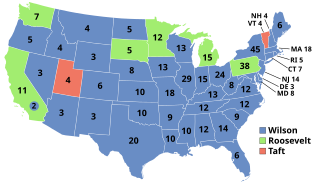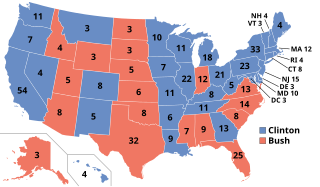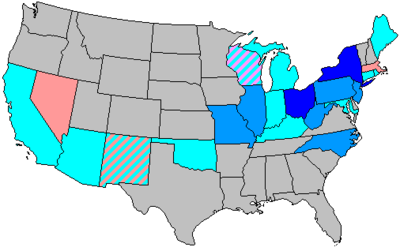
The 1912 United States presidential election was the 32nd quadrennial presidential election, held on Tuesday, November 5, 1912. Democratic Governor Woodrow Wilson unseated incumbent Republican President William Howard Taft and defeated former President Theodore Roosevelt, who ran under the banner of the new Progressive or "Bull Moose" Party. This is the most recent presidential election in which the second-place candidate was neither a Democrat nor a Republican. This is the most recent election to date in which four candidates received over five percent of the vote.
The 1910 United States House of Representatives elections were held in the middle of President William Howard Taft's term.

The 2008 United States elections were held on November 4. Democratic Senator Barack Obama of Illinois won the presidential election, by defeating his challenger, Senator John McCain, and the Democrats bolstered their majority in both Houses of Congress.

The 2010 United States elections were held on Tuesday, November 2, 2010, in the middle of Democratic President Barack Obama's first term. Republicans ended unified Democratic control of Congress and the presidency by winning a majority in the House of Representatives.
The following table indicates the party of elected officials in the U.S. state of Maine:

The 1948 United States elections were held on November 2, 1948. The election took place during the beginning stages of the Cold War. Democratic incumbent President Harry S. Truman was elected to a full term, defeating Republican nominee New York Governor Thomas E. Dewey and two erstwhile Democrats. The Republicans, who had just won both the House and the Senate two years earlier, ceded control of both chambers of Congress to the Democrats. Puerto Rico also elected Luis Muñoz Marín of the Popular Democratic Party as its first democratically elected governor.

The 1986 United States elections were held on November 4 and elected the members of the 100th United States Congress. The elections occurred in the middle of Republican President Ronald Reagan's second term. Democrats regained unified control of both chambers of Congress for the first time since the 1980 elections.

The 1996 United States elections were held on November 5. Democratic President Bill Clinton won re-election, while the Republicans maintained their majorities in both houses of the United States Congress.

The 1992 United States elections elected state governors, the President of the United States, and members of the 103rd United States Congress. The election took place after the redistricting that resulted from the 1990 Census. Democrats won control of the presidency and both chambers of Congress for the first time since the Republican victory in the 1980 elections.

The 1934 United States elections were held on November 6, 1934. The election took place in the middle of Democratic President Franklin D. Roosevelt's first term, during the Great Depression. The Democrats built on the Congressional majorities they had won in the previous two elections. In the House of Representatives, Roosevelt's party gained nine seats, mostly from the Republican Party. The Democrats also gained nine seats in the U.S. Senate, thereby winning a supermajority. A Progressive also unseated a Republican in the Senate. This marked the first time that an incumbent president's party did not lose seats in both houses in a midterm election, followed by 1998 and 2002. The feat of the president’s party seeing net gains in both United States Senate elections and state gubernatorial elections would not be observed again until the 2022.

The 1930 United States elections were held on November 4, 1930, in the middle of Republican President Herbert Hoover's term. Taking place shortly after the start of the Great Depression, the Republican Party suffered substantial losses. The election was the last of the Fourth Party System, and marked the first time since 1918 that Democrats controlled either chamber of Congress.

The 1924 United States elections was held on November 4. The Republican Party retained control of the presidency and both chambers of Congress.

The 1916 United States elections elected the members of the 65th United States Congress. The election occurred during the Fourth Party System, six months before the United States entered World War I. Unlike 1912, the Democrats did not benefit from a split in the Republican Party, but the Democrats still retained the Presidency and the majority in the Senate. Democrats lost the majority in the House, but retained control of the chamber.

The 1912 United States elections elected the members of the 63rd United States Congress, occurring during the Fourth Party System. Amidst a division between incumbent Republican President William Howard Taft and former Republican President Theodore Roosevelt, the Democratic Party won the Presidency and both chambers of Congress, the first time they accomplished that feat since the 1892 election.

The 1908 United States elections elected the members of the 61st United States Congress, occurring during the Fourth Party System. Oklahoma joined the union during the 61st Congress. Despite the Panic of 1907, Republicans continued to control the Presidency and both houses of Congress.

The 1918 United States elections elected the 66th United States Congress, and took place in the middle of Democratic President Woodrow Wilson's second term. The election was held during the Fourth Party System. It was the lone election to take place during America's involvement in World War I. Republicans won control of both chambers of Congress for the first time since the 1908 election.

The 1914 United States elections elected the members of the 64th United States Congress, occurring in the middle of Democratic President Woodrow Wilson's first term. Democrats retained control of both houses of Congress, the first time they were able to do so since the American Civil War (1861-1865).

The 1906 United States elections elected the members of the 60th United States Congress. It occurred in the middle of Republican President Theodore Roosevelt's second term, during the Fourth Party System. Republicans retained control of both houses of Congress.

The 1860 United States elections elected the members of the 37th United States Congress. The election marked the start of the Third Party System and precipitated the Civil War. The Republican Party won control of the Presidency and both houses of Congress, making it the fifth party to accomplish such a feat. The election is widely considered to be a realigning election.

The 1912 Colorado gubernatorial election took place on November 8, 1912. Democratic state Senator Elias M. Ammons defeated the Progressive, Republican and Socialist candidates future Senator Edward P. Costigan, Clifford C. Parks and Charles A. Ashelstrom with 42.91% of the vote.



















